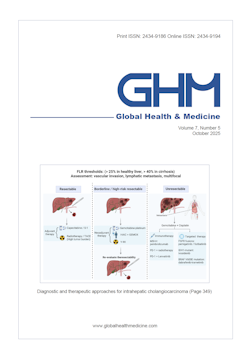Global Health & Medicine 2021;3(2):95-101.
Elevated high-sensitivity troponin is associated with subclinical cardiac dysfunction in patients recovered from coronavirus disease 2019
Hayama H, Ide S, Moroi M, Kitami Y, Bekki N, Kubota S, Uemura Y, Hara H, Kutsuna S, Ohmagari N, Hiroi Y
The aim of this study is to investigate myocardial damage in recovering coronavirus disease 2019 (COVID-19) patients with high-sensitivity troponin levels (hsTnT) and echocardiography. In this single-center cohort study, 215 COVID-19 recovered patients were recruited from all over Japan between April and September 2020. Demographic characteristics, hsTnT levels, and echocardiography data were collected for 209 patients, after excluding those without serum samples or good-quality echocardiographic images. The mean (± standard deviation) age was 44 (± 12) years (range: 36-55 years), and 50.7% of the patients were males. The median time interval (interquartile range) from COVID-19 onset to post-recovery examination was 56 days (34-96 days). Seventy-four recovered patients (35.4%) had hsTnT less than detection sensitivity (< 3 pg/mL) and 135 recovered patients (64.6%) had hsTnT ≥ 3 pg/mL. Ejection fraction was more than 50% in all cases. Left ventricular global longitudinal strain (LVGLS) and right ventricular free-wall longitudinal strain (RVFWLS) were reduced in 62 (29.7%) and 8 patients (3.8%), respectively. They were significantly associated with elevated hsTnT levels. In cases with hsTnT above 5 pg/mL, the LVGLS was greatly reduced to 19.0 ± 2.2% (p < 0.001). Multivariate linear regression analysis showed that elevated hsTnT level was an independent predictor of reduced LVGLS (standardized β = -0.34; p < 0.001). In recovered COVID-19 patients, even a slight increase in hsTnT above detection sensitivity was associated with decreased LVGLS. hsTnT and echocardiography may be useful tools to detect myocardial injury in recovered COVID-19 patients.
DOI: 10.35772/ghm.2021.01025







